Cut support wait times in half with proven tactics that boost retention rates.
Through unique content shared by leading customer support agents, combined with industry-backed data, this article will give you the keys to reduce your time to resolution.
Each strategy comes with real numbers, clear implementation steps, and examples from companies like Abyssale, Consentmo, or ... who've mastered these approaches.
These tricks will help you deliver faster responses and reduce operational costs thanks to real SaaS and e-commerce testimonials that you can steal and employ in your own business tomorrow.
Long wait times lead to customer dissatisfaction and increased abandonment rates, utimately leading to customer churn.
In a period of unstable economy, offering the best customer support is vital to decrease the pressure on marketing, who's always behind the acquisition of new customers.
TLDR For busy support people
Time to Resolution (TTR) measures the total time from a customer’s first message to full issue resolution. It differs from Handling Time (HT), which only tracks how long agents actively work on a ticket.
When to focus on TTR?
👉 Once your team grows beyond 2–3 agents or manages multiple channels — that’s when coordination delays start hurting satisfaction and retention.
Why it matters:
Slow TTR = lost trust, churn, and revenue.
60% of customers hang up within a minute, and each abandoned chat costs roughly $100.
3 Ways to fix it fast
Speed up first replies with AI:
Smart routing + chatbots cut repetitive tickets by up to 40% and reduce response times instantly.
Increase First Contact Resolution:
Give agents full context, fresh knowledge bases, and AI-suggested answers to solve issues in one go.
Prevent reopenings:
Improve reply clarity, follow up automatically, and let AI flag at-risk conversations before closure.
Your 90-Day Playbook
Days 0–30: Deploy routing + automation → Aim at cutting down response times by 50%.
Days 31–60: Refine self-service & pricing → Aim at increase +25% CSAT.
Days 61–90: Train teams & scale with AI → Aim at 95% CSAT, 2× more volume of support inquiry by the AI Bot.
Bottom line:
Fast TTR isn’t about working harder: it’s about using AI and process clarity to deliver faster, smarter, and more human support.
What are the KPIs you can work on to improve your time to resolution?
| KPI | Description | Impact on TTR |
|---|---|---|
| First Response Time (FRT) | Time between when a customer sends their first message and when they get the first human or AI reply | Lower FRT → shorter TTR (sets momentum early) |
| First Contact Resolution (FCR) | % of conversations solved in one interaction | Higher FCR → lower TTR |
| Reopen Rate | % of resolved cases reopened by the customer | High reopen rate increases TTR (indicates incomplete resolutions) |
| AI Resolution Rate | % of conversations fully handled by AI | High AI resolution directly reduces TTR |
| Routing Accuracy | % of tickets correctly assigned to the right team/agent | Poor routing increases TTR due to back-and-forth |
| Internal Collaboration Time | Average delay caused by escalations or waiting on other departments | Lower collaboration time → shorter TTR |
| Agent Workload | Average number of concurrent conversations per agent | High workload often increases TTR |
| Knowledge Base Coverage | % of repetitive queries covered by self-service or AI answers | Better coverage → fewer human interactions → lower TTR |
>>> Download the AI KPI Cheatsheet for tracking your AI ROI in your company
Difference between time to resolution (TTR) and handling time(HT)
While there can be some confusions between what time to resolution means and how different it is from handling time, these two KPIs are in fact somehow related.
But first, here is a clear explanation on how different they are:
Handling time measures how long a support agent actively works on a conversation. Reading, typing, or searching a solution. It captures the effort spent resolving an issue.
Time to resolution, measures the total duration from when a customer first reaches out to when their problem is fully solved and the ticket is closed. It includes waiting time, internal escalations, and any back-and-forth with the customer.
Want to know more about how customer support teams can improve their response times? Check this article: https://crisp.chat/en/blog/improve-customer-service-response-time/
In short, handling time reflects how efficiently agents work, while time to resolution reflects how quickly the entire support process delivers closure for the customer.
Before heading straight into the "how", it is important to think about "when". Not every company should aim at reducing time to resolution.
When should a company start to work on its time to resolution?
A company should start working on its time to resolution (TTR) as soon as it reaches a point where response speed alone no longer satisfies customers, typically when conversation volumes rise and more than one person handles support.
Early on, focusing on first response time is enough, hence why installing a live chat widget is vital for your business.
Below is an example shared by Marc Louvion, who's implemented a chat widget early on to accelerate the product feedback loop and build features that people actually want.
I just set up @crisp_im for my startup and I get 7x more requests than a typical email "support" button.
— Marc Lou (@marc_louvion) May 25, 2025
This is gold if you're building a product where users return daily.
The chat box is hidden from the landing page to avoid spam. pic.twitter.com/MvTqtkwltv
But once you have multiple agents, channels, or handoffs, TTR becomes the key metric for understanding the real customer experience. Long TTRs often reveal invisible friction: unclear ownership between agents, missing automations, poor routing, or lack of context in replies.
But not only. It can also show poor support from technical teams to resolve bugs, lack of ownerships for product teams or even bad customer service company culture.
But in short, here is when you should start to work on TTR:
- Solo or early-stage teams (1–2 agents): focus first on responsiveness and quality.
- Growing teams (3+ team member or multi-channel): start measuring and optimizing TTR, that’s when coordination and process delays start to impact customer satisfaction, churn, and operational cost.
Improving TTR at this stage prevents support backlog growth, keeps teams aligned, and ensures your support scales without slowing customers down.
The risks of a slow time to resolution for businesses
Every extra hour between first contact and resolution costs more than time: it erodes trust, increases churn, and inflates support costs.
Long wait times carry real financial and reputational risks. When customers reach out, they expect fast answers. Yet nearly 60 % of callers hang up within one minute and over 90 % abandon the call after five minutes.
Each missed conversation costs businesses on average around $100, representing a lost sale or churned customer. Long hold times also harm satisfaction levels: they consistently rank among the top drivers of low CSAT scores.
The damage doesn’t stop there. A single bad service experience drives 61 % of customers to switch to a competitor, while others vent publicly. Dissatisfied users are 50 % more likely to complain on social media. Every extra minute waiting increases frustration and the chance that a simple support issue turns into a complex escalation, requiring more agents and higher resolution costs.
In short, slow response times erode trust, increase churn, and invite competitors to win over your dissatisfied customers.
Strategy 1: Leverage AI to reduce time to first message
Artificial intelligence is now a commodity for businesses around the world. Thanks to AI chatbot software, companies can train, personnalize and deploy AI-powered support bots in days.
AI Chatbot are powerful solutions because they stand 24/7, at a large scale. They are now very efficient, allowing business to resolve 40 to 60% conversations on first contact.
But AI doesn't limits itself to chatbots, it fuels a lot of features that are now built-in in numerous customer support solutions.
Why faster first responses lead to faster resolutions
Faster first response time lead to faster resolutions because it is the moment where both you, support agent, and your customers are available to fix the issue. The intention, is high, the motivation is high, everyone is super ready.
Faster first responses lead to faster resolutions because they catch the conversation when engagement and context are at their peak. The moment a customer reaches out, their intention and motivation to solve the issue are high, and your agent is fully in context too.
Responding quickly keeps both sides “in the same moment,” before the user switches tabs, gets frustrated, or forgets key details.
When that first touch happens fast, it sets the tone: the customer feels heard, trust builds immediately, and collaboration begins. This early momentum reduces the back-and-forth, minimizes information loss, and turns what could have been a multi-day exchange into a single-session resolution.
In short, speed isn’t just about reactivity: it’s about capturing the customer’s focus window. The faster you respond, the more likely the problem gets solved while both attention and context are fresh.
How to improve first response time for customer support?
Improving first response time isn’t just about answering faster, it’s about building an AI-assisted system that removes friction at every step of the customer journey. Here’s a practical, four-step approach to make your first replies feel instant, not rushed.
1. Combine smart routing with your AI Chatbot
Your AI chatbot can do more than greet customers, it can route conversations intelligently. by combining smart routing with your AI chatbot, you can automatically assign new messages to the best-fit agent based on topic, sentiment or expertise.
This ensures every conversation starts with the right person from the start: no handoffs, no waiting for context. The chatbot collects key details and sends the conversation where it can be solved fastest.
2. Let AI handle the simple stuff automatically
AI chatbots shine at managing repetitive questions that slow teams down — password resets, pricing details, or “where can I find…” requests.
By letting your chatbot take care of these common queries, your agents can focus on higher-value issues that require human judgment.
Companies like Linear report that AI resolves 30 % of routine questions, saving over 12 hours of agent time per week, time that goes straight back into faster first replies where human attention counts most.
3. Keep customers in the loop with AI-Powered transparency
Long silences kill satisfaction. Use AI-powered automations to keep customers informed while they wait.
Show real-time queue positions, display estimated wait times, and send automatic updates every few minutes. These small touches dramatically reduce frustration and abandonment.
Notion, for example, saw a 15% drop in abandoned chats simply by adding wait-time estimates and proactive status messages.
4. Empower agents with AI assistance
Once a conversation reaches an agent, AI can still speed things up — without sacrificing quality.
Tools like AI-drafted replies, context-aware suggestions, and smart templates help agents respond faster and more accurately.
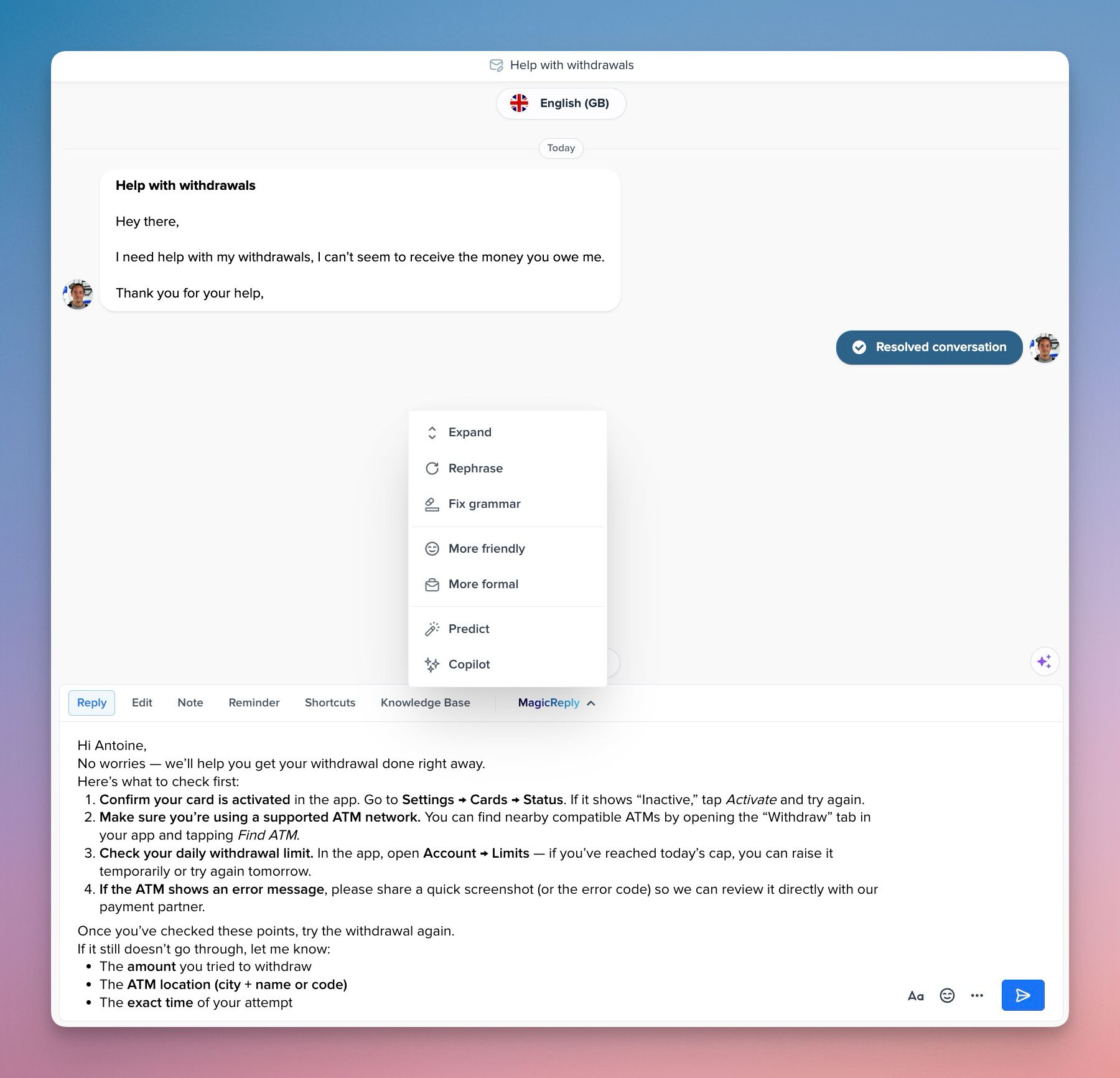
Pair this with continuous tracking of your time-to-first-response, and your team can spot and eliminate bottlenecks before they slow things down. The result? Faster replies, happier customers, and less typing fatigue for your team.
Final takeaway
Improving first response time isn’t just about adding an AI chatbot — it’s about orchestrating how AI and humans work together.
From routing and automation to real-time transparency and AI-assisted replies, each layer helps you respond faster, with more context and less effort.
Strategy 2: Improve your first contact resolution rate
Improving First Contact Resolution (FCR) means solving more issues in a single interaction: no follow-ups, no escalations, no second replies.
High FCR doesn’t just reduce time to tesolution: it also boosts customer satisfaction and lowers operational costs.
Here’s how to strengthen it using the right mix of process, data, and AI.
1. Centralize all customer context before the first reply
The fastest way to resolve an issue on first contact is to give your agents (and your AI) the full picture from the start.
Integrate every channel: chat, email, social DMs, knowledge base into one shared inbox and combine it with a CRM sync that prevents agents from switching back and forth. Make sure agents can instantly see a customer’s history, plan, and past interactions.
2. Strengthen your knowledge base and keep it fresh
A well-maintained knowledge base fuels both AI chatbots and human agents.
When answers are clear, updated, and searchable, your team can resolve more questions in one go — without asking customers to “wait while I check.”
There are tools specifically dedicated to such thing such as Ferndesk that offers integrations with leading support platform such as Crisp.
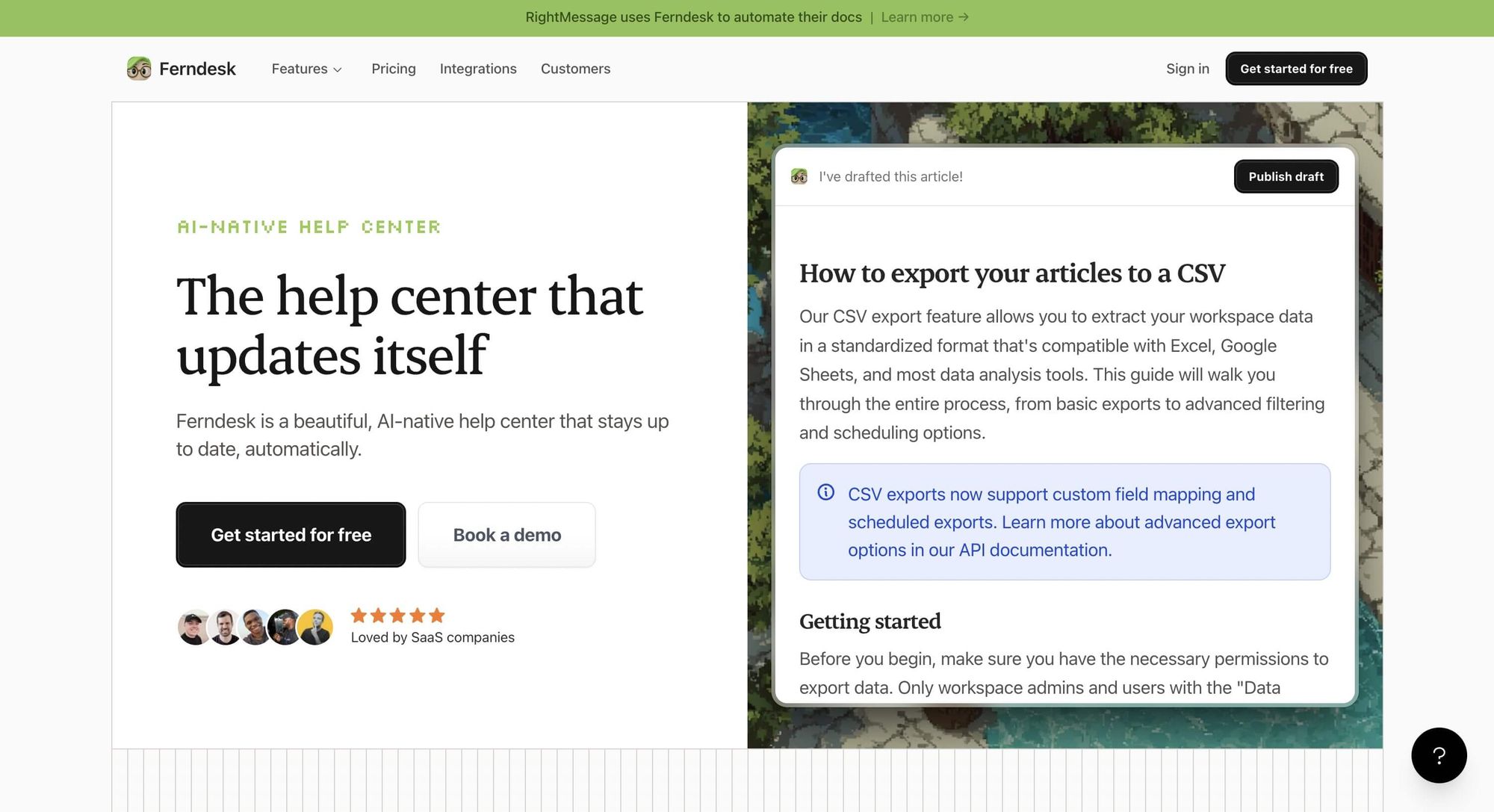
3. Train your AI to suggest the best answers in real time
AI shouldn’t just automate: it should coach your agents as they reply. Set up AI suggestions that suggest relevant drafts containing help articles. This help minimize errors and ensures customers receive complete, context-aware solutions on the first message.
4. Empower agents to take action without escalation
FCR drops when agents need approval to solve simple problems. Define clear “resolution permissions” so frontline agents can refund, update data, or apply small credits without waiting for a manager. Combine this autonomy with AI-powered quality checks to stay compliant.
5. Analyze and learn from reopened tickets
Reopened support tickets are your best clues to why FCR stalls. Track which topics cause reopens, how long they stay unresolved, and whether AI or humans handled them. Then use these insights to improve training, documentation, or chatbot flows.
Final takeaway
Improving your First Contact Resolution Rate is about combining visibility, autonomy, and AI intelligence. When agents have full context, instant access to knowledge, and the authority to act, supported by AI suggestions that prevent guesswork, customers get complete answers the first time they ask.
Fewer follow-ups, happier users, and a noticeably shorter Time to Resolution.
Strategy 3: fix your reopen rate to the lowest possible
Every time a ticket reopens, your time to resolution increases and customer trust takes a hit. A high reopen rate often means answers were incomplete, unclear, or failed to address the root cause.
Reducing reopen rate isn’t just about closing tickets faster: it’s about closing them right the first time.
Here’s how to build a system that keeps conversations closed and customers satisfied.
1. Identify why conversations reopen
Start by understanding the “why.” Pull reports on reopened tickets and categorize them: missing information, unclear instructions, delayed follow-ups, or technical bugs. Patterns will quickly emerge: and those patterns show exactly where to focus your improvements.
Over time, this gives you quantifiable insight into weak spots like poor documentation or inconsistent agent replies.
2. Improve the clarity and completeness of every reply
Vague answers are the number-one cause of reopens. Train your team (and your AI) to write complete, actionable messages: include next steps, links, and verification prompts.
Your goal? make sure customers never have to ask “and now what?”
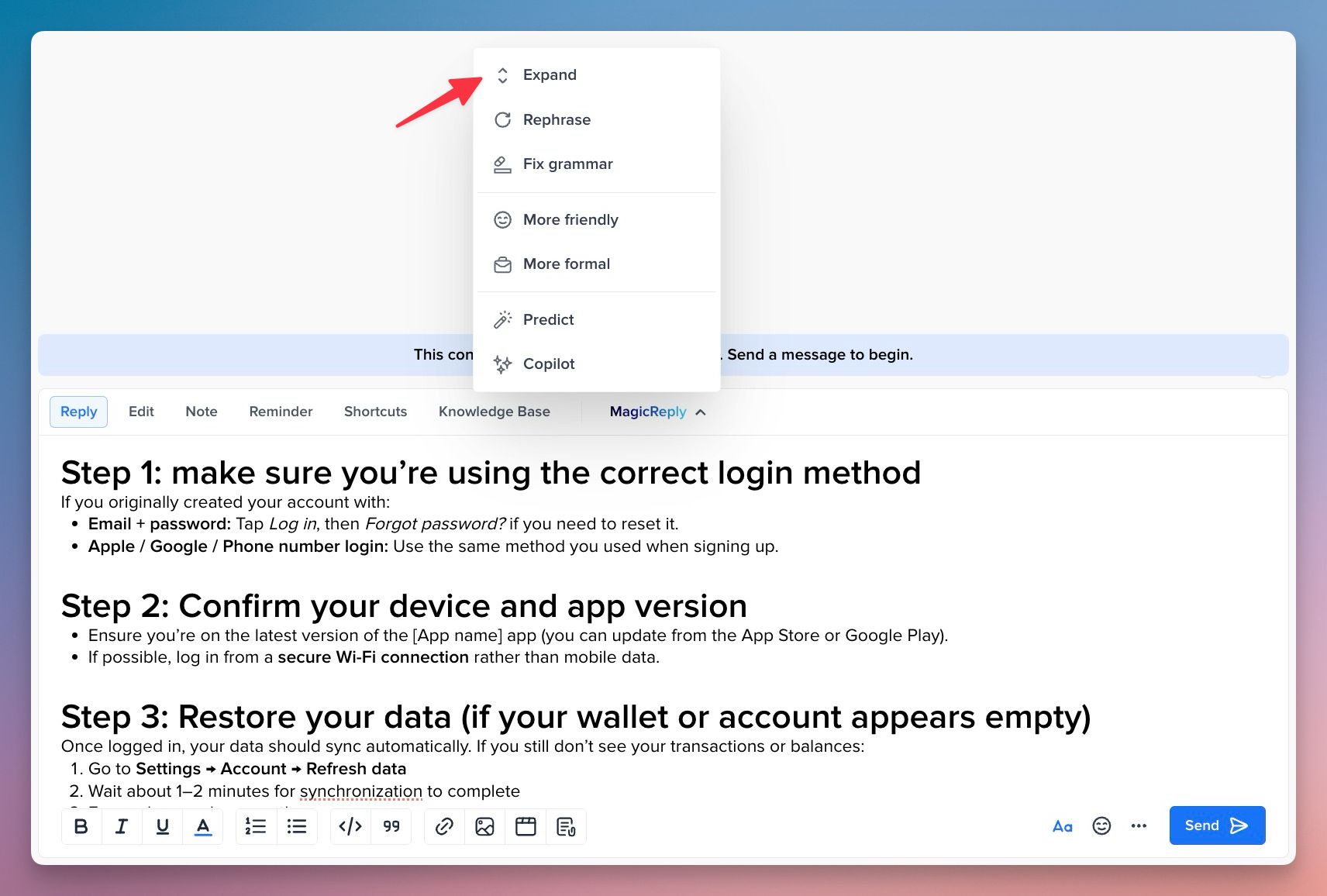
3. Strengthen post-resolution follow-up
Follow-up isn’t a waste of time: it’s insurance against reopenings. Send a quick automated message a few hours or days after closure asking, “Did this fully solve your issue?” If not, your team can reopen proactively before frustration builds.
Combine CSAT data with reopen tags to find recurring friction points faster.
4. Use AI to detect “at-risk” conversations
AI can spot conversations likely to reopen, like vague customer confirmations (“okay, thanks”), unresolved sentiment or worst: frustrations. Set up AI automations that flag these conversations so agents and support managers can double-check before closing.
If the customer sounds uncertain or frustrated, trigger a soft follow-up before marking the issue as resolved.

The 90-days roadmap to improve time to resolution
With this roadmap, we aim at helping you get things fixed within 90 days. No fluffs, no impossible stuffs.
Simple things to enable within your company, either in terms of organizational workflows, or through better setup with your AI-powered customer support software.
Days 0–30: Diagnosis, quick wins and commitments
The first month is all about momentum. Your goal is to remove friction, get your first measurable wins, embark teams and commitment from your managers and show that faster support = happier customers.
By day 30 you shoud have:
✅ Smart routing and automation in place
✅ A list of KPI you're tracking to show impact of your work
✅ Support agents confidently using AI tools
✅ Response times cut nearly in half
✅ A clear story to prove ROI with metrics your leadership cares about
1. Start by measuring what matters
Before fixing speed, you need a baseline. Track your median response time daily, not just the average, to understand real performance.
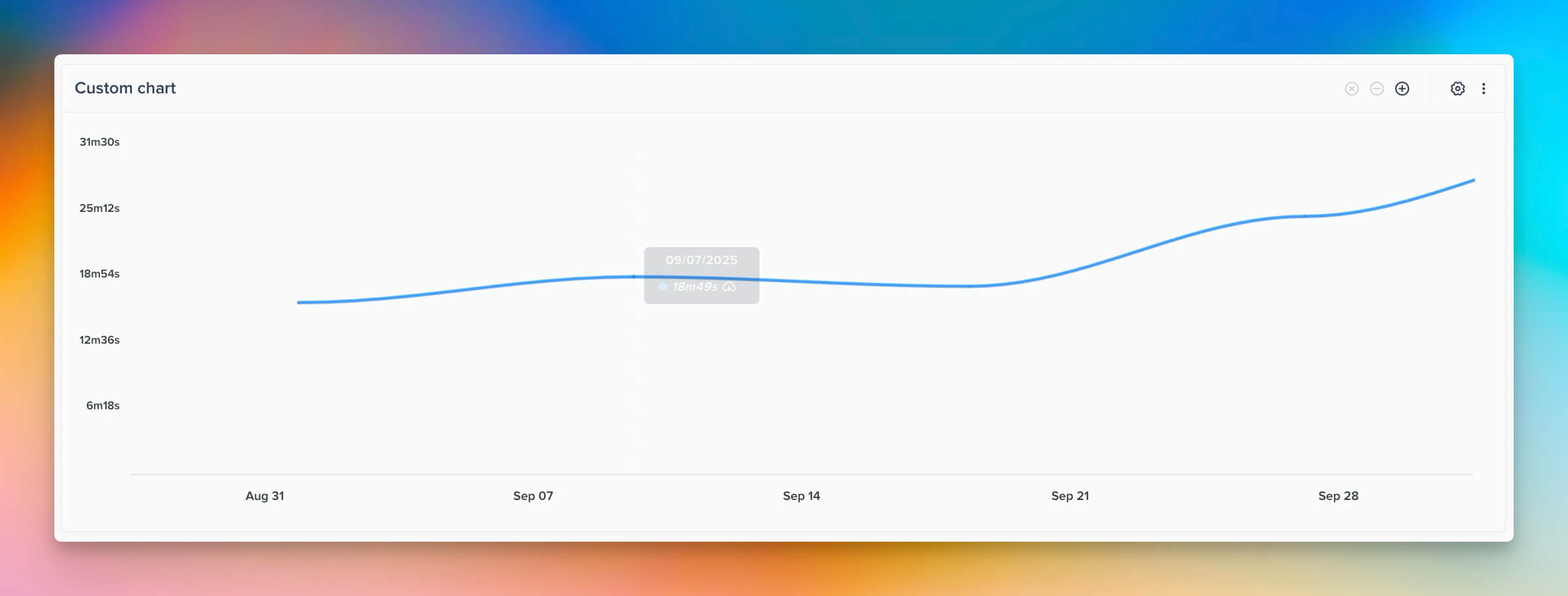
Use your support dashboard to identify the busiest hours and top friction points.
2. Prioritize fast-impact moves
Once you’ve found the friction, apply fixes that deliver immediate ROI:
Set up smart ticket routing based on customers' email, keywords, topic, and urgency, so every request lands with the right agent instantly.
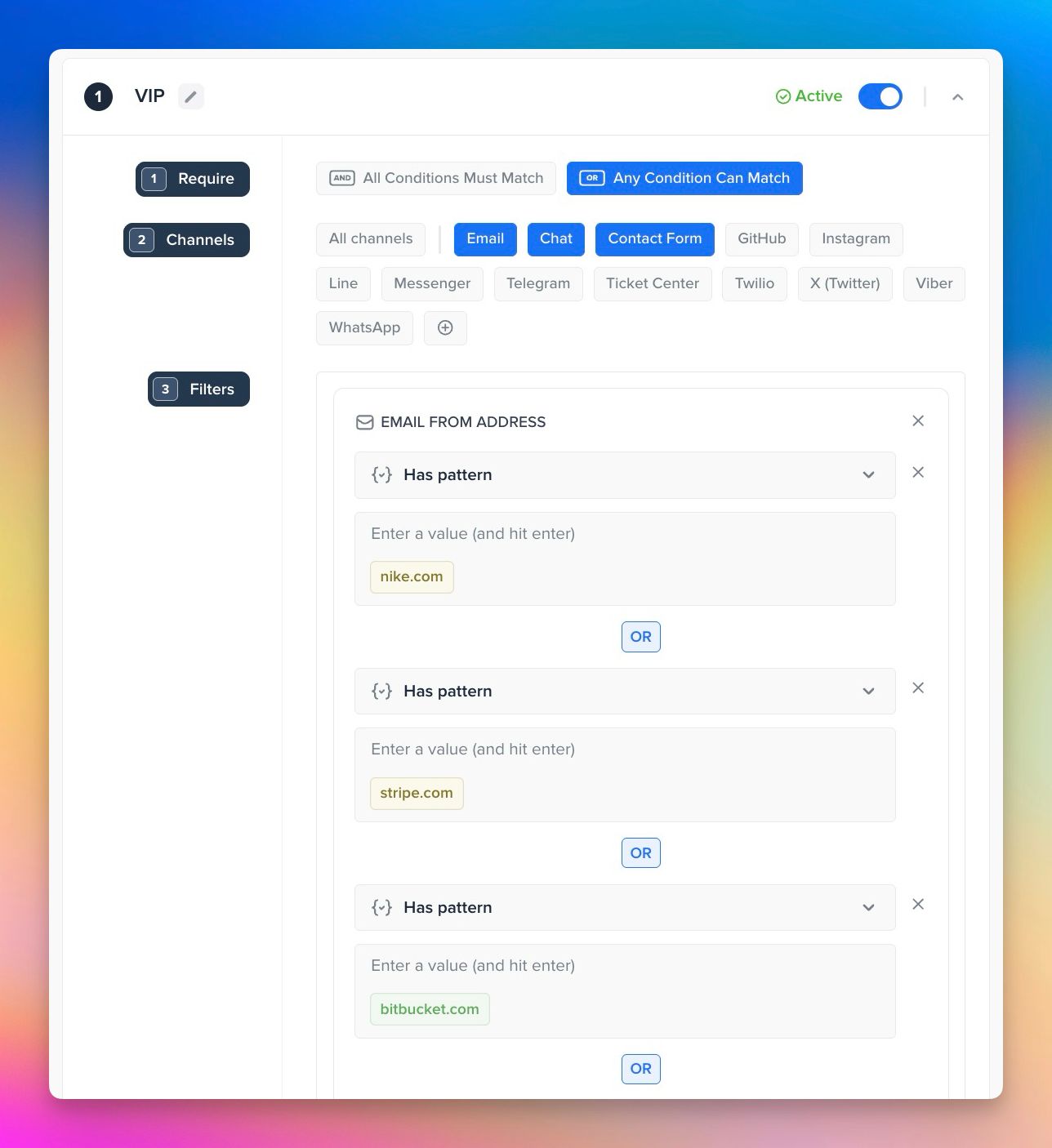
Deploy AI automations to handle common tasks like password resets and billing questions, freeing up your team for real conversations.
Teams typically save 10+ agent hours per week by automating these basics.
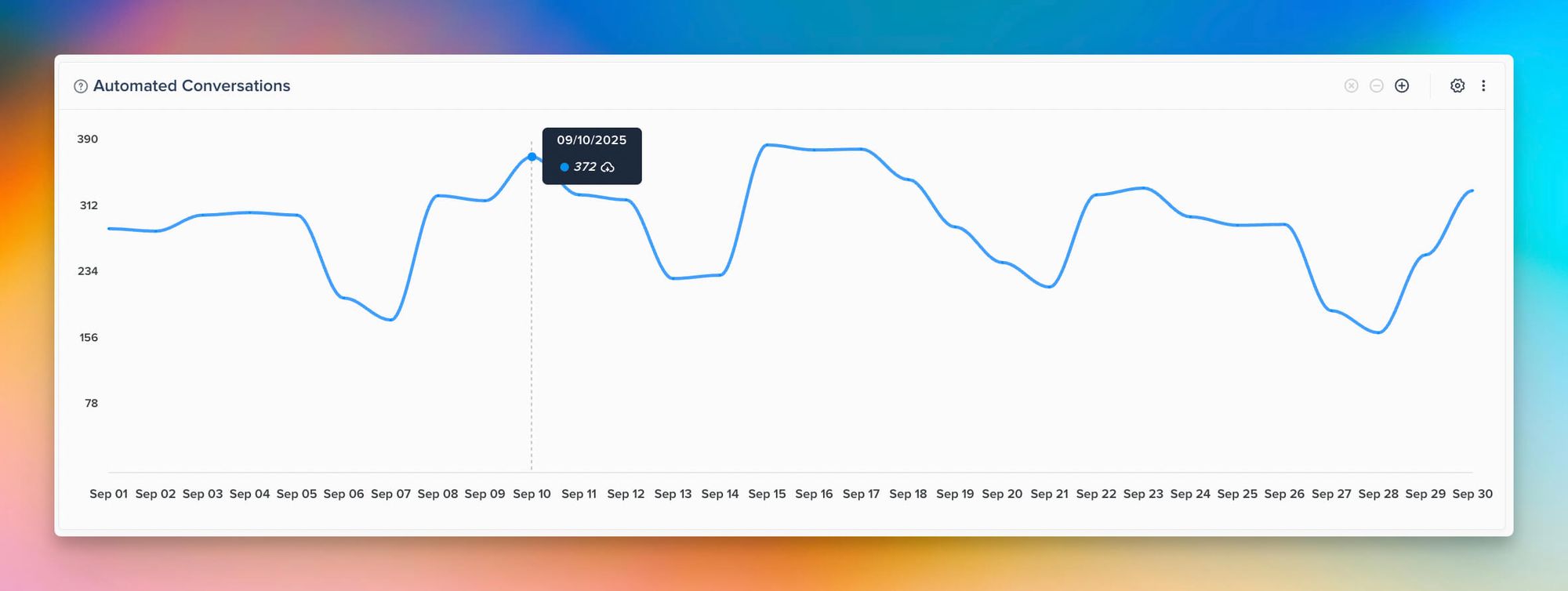
Train your team in focused sprints: 30-minute daily sessions on new tools can increase agent capacity by up to 40% within a week.
💡 Pro tip: Run short internal “response drills” where agents race to clear five pending chats using new AI suggestions. It builds speed and confidence fast.
3. Track, adjust, repeat
Speed only matters if it’s visible. Keep a daily eye on your two core metrics:
First Response Time (FRT): aim to keep it under 5 minutes.
Customer Satisfaction (CSAT): target 95%+ by balancing speed with clarity.
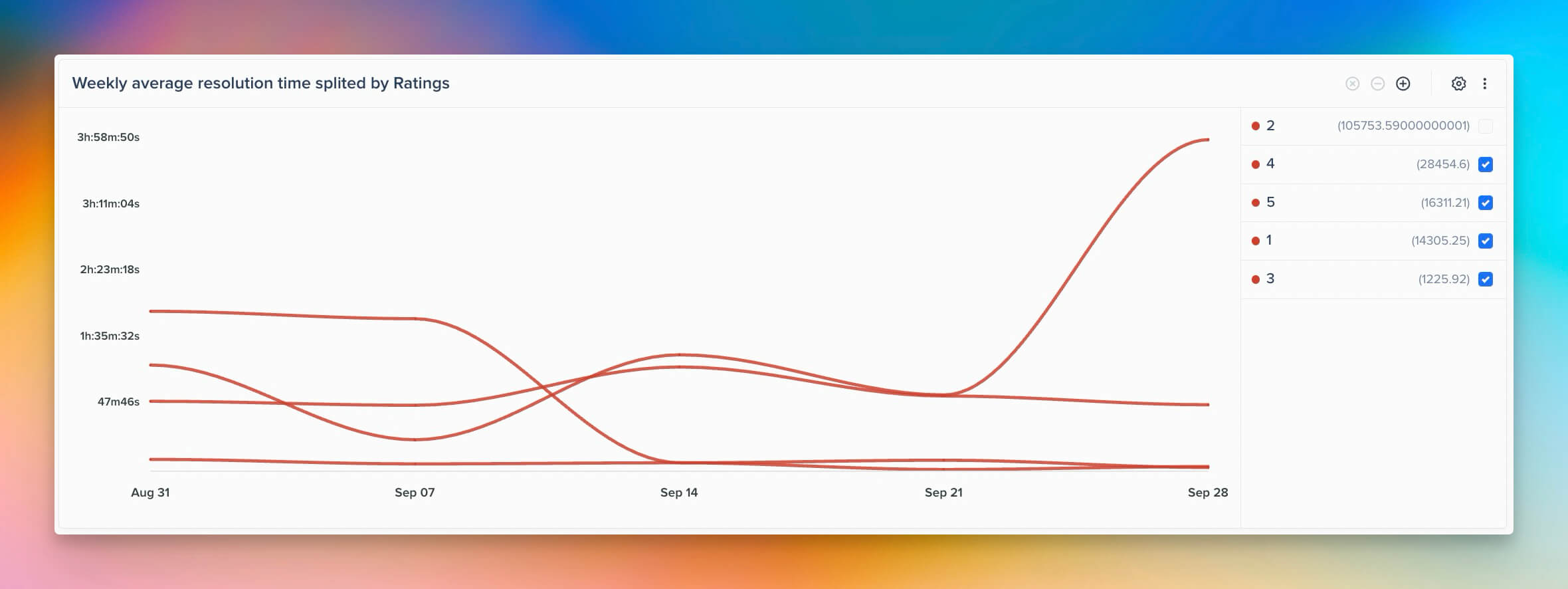
Review progress every week and share results with your team, it reinforces wins and turns data into motivation.
Days 31–60: product & pricing iterations
Once your first-response times are under control, the next step is refinement.
Between days 31 and 60, your focus shifts to optimizing your product experience and pricing clarity: two levers that directly impact satisfaction and retention.
Companies that implement these refinements typically see a 25% increase in customer satisfaction scores.
The impact you should aim at day 60:
✅ 25% higher customer satisfaction
✅ Lower call and chat volumes
✅ More consistent resolutions
✅ Reduced financial losses from abandoned conversations
1. Enhance self-service strategy to accelerate time to resolution
Long wait times are more than a frustration, they’re expensive. Each abandoned conversation can represent a $100 loss, and the reputational damage compounds over time. To prevent that, empower customers to find answers before they even start a chat.
Expand your self-service options with AI-assisted knowledge bases and search widgets.
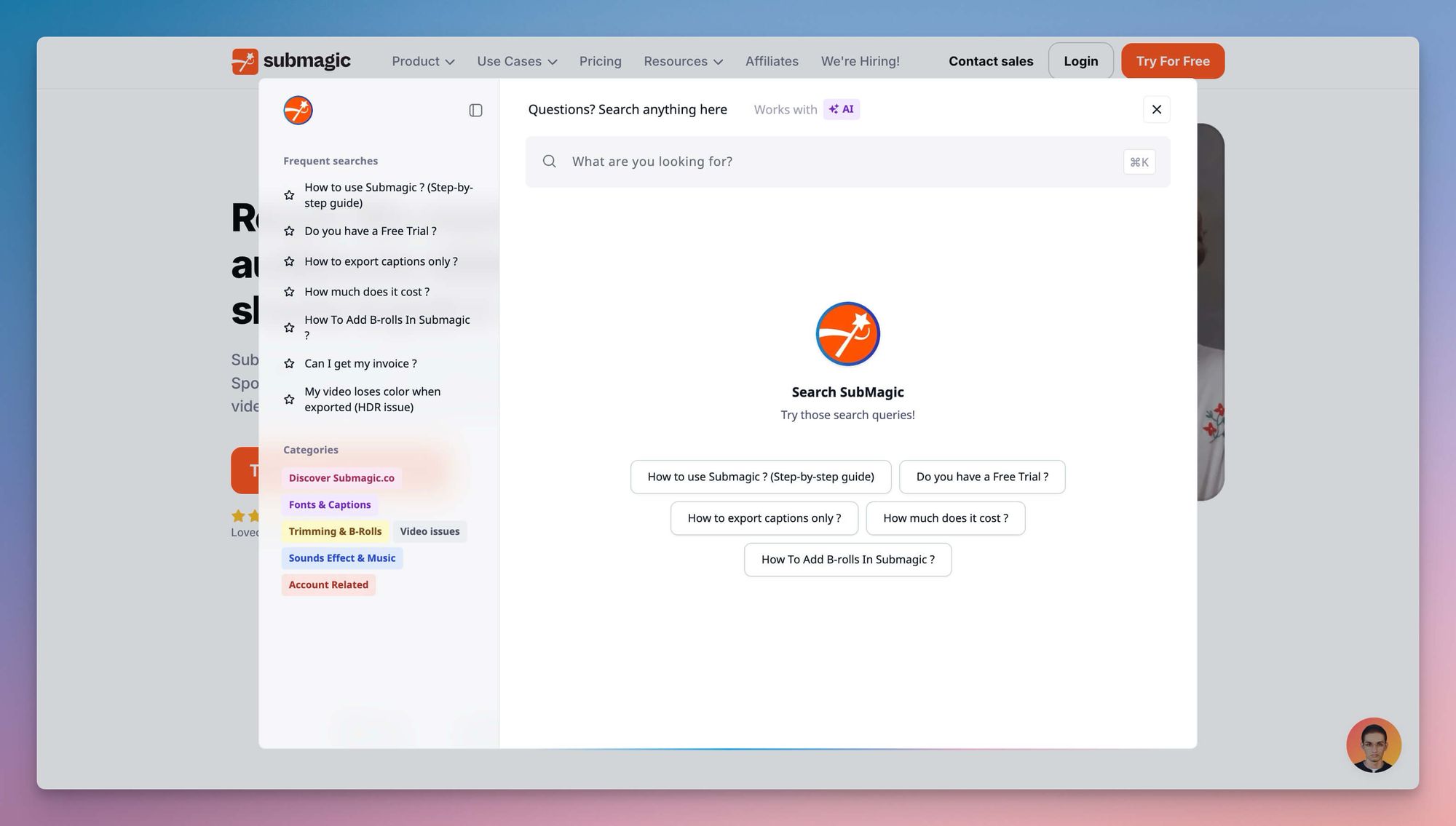
2. Simplify and communicate your pricing clearly
Unclear pricing drives unnecessary support volume — and frustration.
Make sure your pricing page answers questions before customers have to ask:
- Clarify what’s included in each plan (features, limits, and AI options).
- Add a quick comparison chart to reduce confusion between tiers.
- Include a “Talk to us” CTA for edge cases like custom billing or overages.
At Crisp, we revamped our pricing page this year and it drove a huge impact on signups.
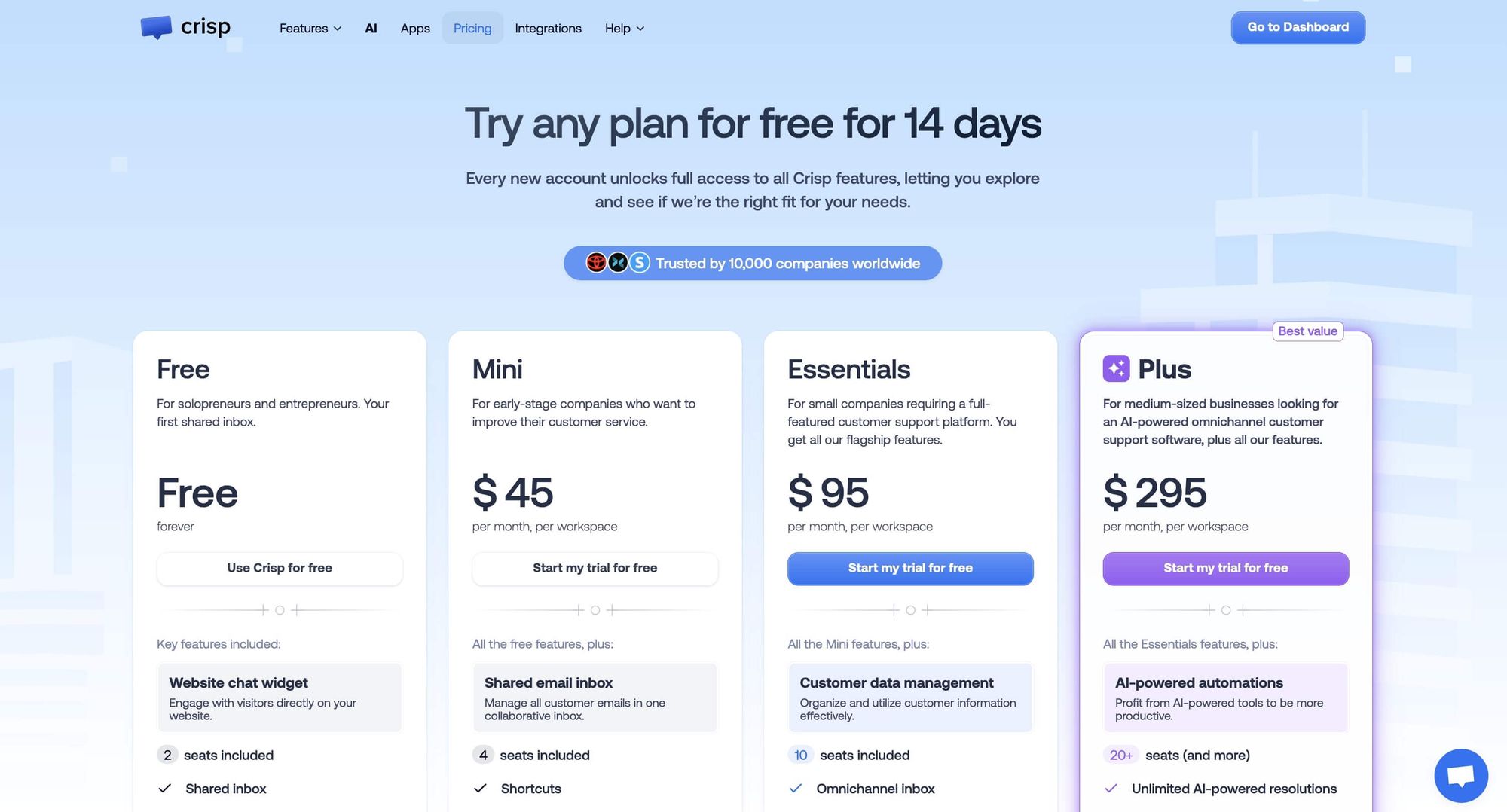
3. Implement Smart AI assistance with a human fallback
AI can now handle a majority of incoming requests, but the key is knowing when to hand off. Set up your chatbot to handle simple, repeatable issues (billing, password resets, setup questions) while automatically escalating complex cases to a human agent.
This balance keeps queues short, ensures quality, and builds trust.
Days 61–90: Scale & enablement
By this stage, your foundation is strong: fast responses, higher first-contact resolutions, and fewer reopenings. Now it’s time to scale your support operation to handle double the volume while keeping satisfaction sky-high.
By day 90 you should have:
✅ Agents confidently resolving complex cases.
✅ AI handling 40% of volume autonomously.
✅ Product and support teams aligned through feedback loops.
✅ CSAT above 95% and response times cut in half.
1. Train for complexity with daily 30-minute sprints
Fast teams are trained teams. Run short, focused sessions where agents tackle your five most complex case types: billing disputes, failed transactions, or API errors, for example.
This continuous micro-training keeps skills sharp and builds confidence.
2. Sync weekly between Product and Support teams
Your support team sees product friction first, don’t let that insight go to waste.
Hold weekly 30-minute product-support syncs to share recurring feedback, confusing UX patterns, or feature requests. When support and product align, customers get faster fixes and fewer repeat issues.
3. Use AI to absorb routine volume
By now, you know which types of questions repeat most often — let AI take over.
Configure your chatbot to handle around 40% of routine requests automatically: password resets, invoice downloads, plan changes, etc.
This automation gives your team back 15 hours per week, freeing them to focus on higher-impact customer needs.
4. Track performance and react fast
Growth can expose weak spots. Keep your metrics visible daily: CSAT, First Response Time, and Resolution Rate. And set alerts for any number that dips below your targets.
This makes it easy to act on issues before they cascade into customer frustration.
Use-cases from all around the world
Below are stories shared by companies that have successfully tackled long support response time thanks to AI and other means.
Abyssale
Story shared by Guillaume Stigliani, Head of Operations at Abyssale
We have build an AI bot that is handling most requests, but we’ve learned that adding a human touch makes a huge difference. If an issue is complex, unclear, or the user struggles to give enough context, we offer a quick Google Meet screensharing session. This helps us identify the real problem much faster, we don’t necessarily fix it live, but understanding it clearly saves a lot of time later.
The key is to stay straightforward and guide the conversation during the call, otherwise it can easily turn into a complaint session. On the other hand, if time allows, it’s a great opportunity to share tips and tricks about using the platform.
It really boosts satisfaction and helps users get more value out of the product. Even if the issue takes longer to fix, customers really appreciate the personal attention — it makes a big difference in an AI-driven era.
Operationally, we also created two Slack channels to streamline follow-up: one for minor bugs, forwarded to the tech team to fix when possible one for major issues, where the tech team jumps in immediately.
This combination of AI efficiency, human interaction, and structured escalation has significantly reduced our time to resolution and increased customer satisfaction.
Bridge Ops
Story shared by Yoann T., Customer experience specialist at Bridge Ops
Improving resolution time isn’t about replying faster: it’s about understanding faster.
When companies identify the true intent behind each message, they can route, automate, and resolve issues instantly.
AI now acts as a real teammate: sorting requests, retrieving key data, and answering instantly when possible.
Human agents focus on the complex, emotional, and high-value conversations where empathy matters most.
This shift removes repetitive work and accelerates every step of the support process. At Oeni, Crisp automations saved 51 hours monthly; at Submagic, response times dropped by 95%.
These results come from smarter workflows, not just better tools.
Connecting AI to customer data creates context-rich experiences and faster resolutions. The outcome is clear: fewer inbound requests, lower costs, and higher satisfaction.
Every question ends up in the right place, through the right channel, at the right time.
ProntoHQ
Story shared by Nicolas F. from Pronto
At ProntoHQ, we’re known for our ultra-fast and high-quality chat support: it’s a core part of our value proposition and something our users consistently highlight. Here is how we improved our resolution times with Crisp.
1. We moved from a “queue” mindset to full ownership. Each of our 5 support reps now owns specific customer segments instead of picking random tickets. They know the context, past issues, and business impact — so there’s less back-and-forth and faster, more confident replies. This shift alone reduced our average resolution time by about 35%.
2. We automated all the low-value tasks. We built workflows to auto-tag conversations, detect urgent cases, and handle repetitive questions. We also created a support video with chapters for every key use case, and each chat message can automatically refer users directly to the right video chapter.
This approach drastically cut repetitive questions and improved self-service efficiency.
Lyter
Story shared by Lilian M. from Lyter
Centralizing all user requests in Crisp, which gives our team instant access to each user’s context, history, and account details. This helps us avoid unnecessary back-and-forth and solve issues much faster. Creating predefined support templates for our most common requests (LinkedIn connection, post generation issues, billing questions, etc.). This allows our team to reply in seconds while keeping messages clear and consistent.
Common mistakes & anti-patterns for bad response time management
Delayed responses: High abandonment rates and customer frustration stem from overwhelmed teams.
Missing key metrics: Without data, you're flying blind. Teams waste time on ineffective strategies.
No follow-up: Customers left hanging leads to unresolved issues and lost trust.
Poor ticket management: When support tickets slip through cracks, customers suffer.
Ignoring feedback: Valuable customer insights go to waste while same problems keep recurring.
Tools and templates that are leveraged to improve support resolution time
These tools below are shared by companies who answered the surveys we published recently. The question was referring to tools (appart from customer support platform) they were using to improve their time to resolution.
Discord
Discord is a free communication platform for text, voice, and video chat, originally popular with gamers but now used by communities of all kinds. It allows users to join or create public and private "servers," which are organized into different channels for specific topics, and also supports direct messages and group calls. Users can share files, links, images, and screens, and servers can be enhanced with automated bots
Basically, it is a tool that is leveraged as an internal messaging app for businesses and escalate complex support inquiries.
Notion
Notion is a versatile, all-in-one workspace that combines notes, tasks, wikis, and databases into a single platform, allowing users to organize projects, manage knowledge, and collaborate in real time. It uses a flexible, block-based system that users can customize with different layouts like tables, boards, and calendars to build a connected workspace tailored to their specific needs.
Basically, support and ops leaders are leveraging Notion to improve centralize their company's knowledge such as internal workflows or roadmaps.
WhatsApp Business
WhatsApp Business is a free app that provides tools for businesses, especially small ones, to communicate with customers professionally and efficiently. It allows you to create a business profile, showcase products and services in a catalog, and use automated messages and quick replies to respond to customer inquiries. The app works separately from the standard WhatsApp Messenger but has a similar interface, offering features for customer service and marketing.
Suprisingly, some companies are leveraging WhatsApp Business as a mean of communication for internal purposes. They combine it with Discord, which is also an internal messaging platform.
Google Meet
Google Meet is a video-conferencing service by Google that allows users to hold secure virtual meetings through video, audio, and chat. It can be accessed via a web browser or mobile app, is integrated into Google Workspace and can be used for both professional and personal communication, like business meetings or casual calls with friends and family.
Google Meet is used as a mean to better understand complex support inquiries when chat conversation is not enough. eg debug or dig into a problem that isn't clear. It is efficient as voice conversations are always faster and more efficient but less scalable.
Sources & references
- https://www.callcentrehelper.com/
- https://www.geckoboard.com/best-practice/kpi-examples/first-response-time/
- https://crisp.chat/en/pricing/
- https://dialzara.com/blog/missed-calls-hidden-costs-and-ai-solutions
- https://getmindful.com/blog/how-long-should-customers-hold/
- https://ipfone.com/what-is-the-value-of-a-lost-call-to-your-business/








